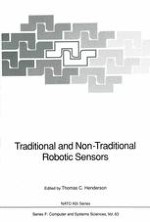1990 | OriginalPaper | Buchkapitel
Video-speed Triangulation Range Imaging
verfasst von : P. W. Verbeek, J. Nobel, G. K. Steenvoorden, M. Stuivinga
Erschienen in: Traditional and Non-Traditional Robotic Sensors
Verlag: Springer Berlin Heidelberg
Enthalten in: Professional Book Archive
Aktivieren Sie unsere intelligente Suche, um passende Fachinhalte oder Patente zu finden.
Wählen Sie Textabschnitte aus um mit Künstlicher Intelligenz passenden Patente zu finden. powered by
Markieren Sie Textabschnitte, um KI-gestützt weitere passende Inhalte zu finden. powered by
When a light plane is projected on a scene, the resulting profile line can be recorded by a camera system looking from aside. This technique for range imaging with a 1-D or 2-D video camera is well known. It takes the recording of an image line (say 256 pixels) to establish the position of one profile point. If a 1-D video camera (line camera) is replaced by a Position Sensitive photo Detector (PSD) the position is found from only two current values, simultaneously measured. A speed gain of 256 is thus achieved. However, like the line camera the PSD is a 1-D detector that needs a scanning device to measure the different parts of the profile lineWe want the speed gain without the scanning. Therefore, we propose to replace the 2-D videocamera by a novel type of line profile detector: an array of PSDs that allows recording of a profile in a video line time (64us)To realize a video-speed range camera a PSD-array chip has been constructed. On the 10 × 10 mm2 large chip a row of 96 single PSDs have been implemented to be read out externally. In the experimental configuration a fan beam strikes the surface of a test object (cross section 100 × 30 mm2). With a 50 mm camera-lens the illuminated profile of the surface is imaged on the array sensor. The arrangement used is of the triangulation type: the height z at a lateral position xi at the object is sharply imaged at position z’ on the corresponding single PSD numbered “i”. The position z’ and thus the height z follow directly from both currents of the PSDUsing a 2MHz clock and a multiplexing system all 96 PSDs can be read out in less than a video line time. By moving the object relative to the fan beam (either by a conveyor belt or by a scanning mirror) a real time video image of 256 range profiles is formedIn this paper preliminary results are given, based on the read-out of a subset of eight PSDs of the array sensor
